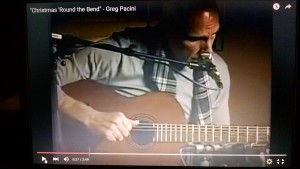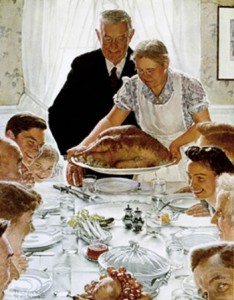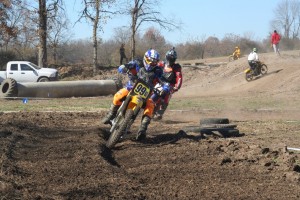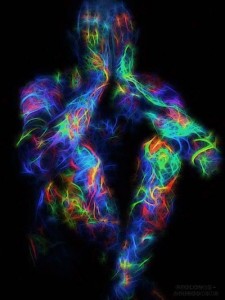
Had an article all queued up two weeks ago for this last Thursday in 2015: all about the uselessness of worry. Then life served up a chance to practice what I was preaching.
St. Louis saw record rainfall earlier in the week. This photo is my front yard on Monday. On Sunday, the lake my home sits on breached its containment, and the watch ensued. Levels held pretty steady until about 3 a.m., and from there the water steadily rose. 
By 10 a.m. on Monday morning, the lake seemed close to crest, still needing another foot plus to reach my basement. Feeling pretty confident that my neighbors and I had bested the worst of the storm, I went downstairs to exercise a bit.
Well, well, well. What have we here? When I reached the bottom of the steps, the carpet splashed. So even though the water hadn’t reached the exterior level of my basement, the sewer system supporting these low-lying homes couldn’t handle all the water, and it was tumbling up out of my basement drain.
Pretty sure there was one f-bomb, then to work. First I put soup cans somebody gave me under the legs of a table I’d made, and put my drum kit on top of that. Next was the P.A. system up the steps. Then albums and all sorts of stuff where stacked on metal chairs. Lastly, boxes of CD’s and books were taken upstairs.
Eventually, the drain started acting right, and water went back underground. I used a sheet of plywood like a big ole’ squeegee, and pushed water to the drain. Thankfully, the basement is not finished, so only the carpet at the bottom of the stairs was soaked. In time, I hosed down the little sewage that came up, hit the carpet with a shop vac, dried the whole thing with fan and heater and lastly did some disinfecting.
Who knew life was gonna offer up an occasion to experience myself in higher stress. And while my mind wanted to spin scary stories, it didn’t. And that was the whole point of the original article about the uselessness of worry. Unless we’re being chased by a dog or somehow seriously threatened, worry is useless.
Worry cops our energy. It weakens our focus. It steals oxygen from the brain, making clear communication and thinking difficult.
So why do it? Worry can be companion to a mind hooked on overactivity. Worry can give a place for anxious energy to land. Worry can also give us a a sense of self, albeit a broken one. When you think about it, worry begins to sound somewhat self-involved.
So if you care to, please join me in leaving any habit of worry in 2015.
Here’s a three step process to help:
Step 1. Get familiar with your worry. Notice when it’s beginning and ending. Your body can help with its Stress Activated Signals (S.A.S.). These signals include things like ears getting hot, tightness in chest, sweaty palms, choppy sentences and stomach upset.
Step 2. Recognize in this moment of worry, you have the following choices: fight the situation, get away from it, freeze with fear, or flow by taking the next right step, trusting the step after that will be clear once you take the next right step.
Step 3. Choose*
*Consistently, the flow response has proven to be for me the most effective, efficient and comfortable way to react to worrisome situations. It’s also the one that comes with the most peace.**
**May peace visit those whose homes and livelihoods have been seriously compromised by the flood.
There’s a lot to get done during the holidays. But our Western approach to getting something done often contrasts the Eastern approach to getting something done. And yet perhaps there’s no better time to adopt a more Eastern approach than the holidays.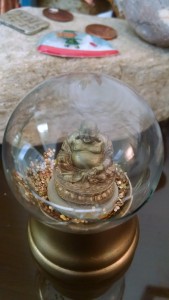
The Western approach tells us there’s no value in sitting around. In so much of our part of the globe, it’s all about how much you accomplish, and accomplishment looks like success and money and things. Nothing wrong with any of that, unless that’s the only thing that accomplishment looks like.
A more Eastern approach tells us that “sitting” is highly prized and perhaps accomplishes the most important things in life.
What if accomplishment this holiday season was the simple act of sitting quietly with your child before the Menorah or Christmas tree?
Because many adults feel they were valued as children only for how they “performed” and what they could do, those adults now don’t know how not to do. When things are quiet and cozy, they get the itch. The itch is made up of two things: being cozy doesn’t register as “doing,” so it feels like not doing enough. And, “doing” feels much more familiar. So they scratch the itch and get busy.
Another way to say it is that “doing” often reflects intolerance for connectedness or intimacy, whether emotional or physical.
During the holidays, this intolerance for intimacy might look like the woman who always seems to have one more thing to do in the kitchen or office, at the very moment her husband wants to snuggle. Or the intolerance for intimacy might look like the man who has to throw down salt one last time on the dinner or sidewalks the second his wife looks at him with loving eyes as they settle in front of the fireplace.
Perhaps everyone would have a better holiday season if we could just sit, and let moments of intimacy connect us to our hearts and each other. It’s OK. We can always create separateness. If you’re a doer, you’ve got that down.
So while even the Buddha is impermanent, there will always be moments to comfortably connect, and isn’t that what we all want at the deepest level, especially during the holidays?
When we are loved, just as we are, we learn to trust our own instincts. Once we trust our own instincts, we move forward in life with a sense of sureness or resolve.
Love is a powerful thing. It’s like light. Doesn’t that TV commercial say the human eye can detect the light of a single match in the dark, ten miles away? Dang.
Love seems to operate in the world like that. The unconditional regard from one person to another can bring light to years of darkness from abuse, rage or hurt.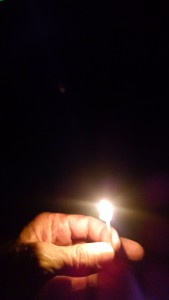
And when years of hurt and darkness in a person are illuminated by the light of love, that loved person goes forward with a new light that brightens the eyes of many that person sees over the course of a lifetime. And then all those people touched by that light which was once darkness bring more light into the eyes of all those they see. Love has this power in the world. Love has this power in the heart.
The resolve born in the heart of a person who feels truly loved changes the way life feels for that person.
First the person loved begins to feel strong enough to look deeply into the eyes of his or her own emotions: fear, anger, sadness, joy, hope.
Once those emotions are fully accepted in the self, those emotions provide better guidance. With better guidance, now from within, the self creates a life that feels better.
From this life that feels better, the self loved deeply by another begins to love deeply the self. When we love ourselves deeply, we become more clear about who we are and what we want.
As we become more clear about who we are and what we want, decisions come more easily. As our decisions, based on guidance from our own feelings, produce a better life, we walk moment to moment with a core, solid, palpable sense of resolve. This quality of resolve supports us feeling safe in the world, because we feel safe with ourselves.
Fear seems contagious, but so does love. Which will you catch?
Thanks to Oprah, gratitude journals were all the rage a while back. And while most wouldn’t peg me as a hipster, thanks-giving has real appeal. That’s because the simple act of gratitude can upshift our immune system. And the on going practice of giving thanks can actually change us at the level of our DNA–maybe more.
Cell biologist, Dr. Bruce Lipton, has a great DVD presentation called, “The Biology of Perception.” In it, he outlines some fascinating fundamentals about how we function at the cellular level, and how that translates to the way we are in the world at large.
In his presentation, Dr. Lipton wonderfully explains the notion that our bodies are always operating in one of two basic modes: growth or protection. Always [and only] one mode or the other. Never both. This paradigm overlays perfectly with the work of Gary Zukav who says we constantly move between two inner states: love or fear. Dr. Lipton describes love to be the number one ingredient for supporting growth in humans. Gratitude is love: love for someone, love for something, love for someplace, love for some belief. All gratitude.
This is where it gets interesting. Our body’s general mode of living or being in the world begins at the level of perception. For example, I love racing motorcycles. Therefore, no matter how many others perceive racing as dangerous, when I race my systems kick into the growth mode since I perceive racing as awesome. When we are in growth mode, our immune systems are bolstered. That’s because when we are in a state of love or gratitude, healthy blood flow is maintained to the gut where the immune system is born. That’s unlike the mode of protection or fear, by which blood is forced out of the gut, to the arms and legs. For me, racing motorcycles establishes a state of love, born of gratitude, which produces growth or health in my body. That’s assuming, of course, I “keep the rubber side down.”
But that’s the thing. What do you think happens to the immune system of someone who cares about me, but perceives racing as dangerous, when she watches me on the track? That person’s body will go into protect mode. In protect mode, the body squeezes blood out of the gut and core organs, and sends that blood to the limbs, readying for fight or flight. Because this fear state robs the belly of blood, the immune system living in the gut of that person watching me race takes a hit. At that point, that spectator is far from a mode of gratitude. And this interrupts growth. All of this gets reflected in the hormonal and nervous systems. And all this has the potential, according to Dr. Lipton and others, to literally redo DNA. (Remember The INNERnet?)
We have the same external event, a motorcycle race, producing a growth response in one person and a protection response in the other. What creates the difference in responses? Not the race. It’s each person’s perception of the race. Think of the implications of perception, beyond a race. How often do we protect simply because of a perception? And what might happen if we had a growth response instead?
Here’s the last and maybe most interesting of Dr. Lipton’s points. This basic love/growth versus fear/protection process begins at the cellular level. He tells us that if you lay a single human cell in a petri dish, and put some form of nutrient near that cell, the cell moves toward the nutrient and grows. But if you put that same human cell in a petri dish and place a toxin near it, the cell moves away to protect itself.
Now multiply that basic process by trillions, the number of cells in each human being. Then multiply that by billions, the number of us on the planet. Dang, that’s a lot of cells and humans either growing or protecting. Nonstop, all of us are either growing or protecting!
So, gratitude and love expand us. Fear and protection contract us. What would happen if all the cells of all the people in the world expanded in gratitude at the same instant? It all starts with perception. Do we look out at the world and see good, or something else?
With that, the prescription for the health of our species comes into focus. When we all find reason for gratitude, the human race grows in love.
Happy thanks-giving.
The tragedies of Paris, Beirut and Russia threw those countries into deep sorrow, and at the same time, opened wounds of grief in hearts around the world. When someone we love is hurting from grief, we want desperately to take that pain away. Consequently we say things we hope will help. But words often miss the mark. When someone is grieving, just being there is more important than anything we can say.
“It’ll get better,” “God has a plan,” “I understand”: these words are meant to make the person we love feel better. Having worked with the chronically and terminally ill for more than 25 years, I can tell you, more often than not and despite our best intentions, words like those don’t help.
In fact, words like, “Be strong,” or, “It could be worse,” or, “It’ll all make sense one day,” often shut down someone expressing strong emotion. And when we’re in a world of hurt, literally and figuratively, most of us just want someone to share our pain, not shut it down.
Instead of words, let your presence speak for you.
No words can take away the deepest pain of loss. Mostly words just get in the way. But when we simply show up for someone that’s grieving, our presence says more than any words could. Our presence lightens the weight of isolation someone grieving might feel. Being there also says, “I can handle your pain, no matter what.” This makes a difference.
Hope is like cornering: lean in a little and let go. Otherwise you interfere with the flow of things.
Racing has taught me a lot. If you train your eyes on some nasty cross-rut or rock in your line, that’s exactly where your body takes you and the bike. Next thing you know, you’re down and picking up parts.
But if you focus instead on where you want to go, your body takes you and the bike there. Somebody once told me about a guy on a motorcycle at a crossroads in the Branson area. The biker decided to shoot between oncoming vehicles. Unfortunately, traffic was too fast and a car clipped the motorcyclist.
Here’s the telling piece. When you looked at skid marks left by the car, the dark lines curved right into the biker! The car driver did exactly what most of us would have done: set his eyes on the darting motorcycle. But, had the driver of the car looked instead at where he wanted to go (straight ahead) he would likely have missed the biker. Where we focus is where we go.
Biking has also taught me about hope, and it’s a lot like cornering. To corner, it’s best to simply shift your weight into the corner and then let nature takes its course. Relatively effortless, actually. But it’s easy to overthink and oversteer. The result: you get off course.
Life’s like that. Hope seems to serve us best when we gently point our hearts in the direction of what we want, and then let go. After that initial setting of direction, if we overthink it, or focus too much on getting what we originally hoped for, our actions get skewed and the natural course of things can no longer flow.
In this way, hope seems to engender a little trust.
When we’re madly in love, it’s all good. Or so it seems. When we’re madly in fear, what felt like love now just feels like madness. Here are some thoughts about distinguishing the madly in love from the madly in fear.
We all have two needs: the need to be connected and the need to be separate. Behind each of these two needs is a fear. Behind the need to be connected is the fear of being over-connected or engulfed. Behind the need to be separate is the fear of being over-separated or abandoned.
When you are healthy, your relationships reflect that health. And healthy means you balance your need to connect and your need to be separate. So does your lover. Your choice of lovers mirrors all that’s wonderful about you and all that’s wounded. In keeping with this mirroring, healthy lovers mutually recognize and honor both needs for connection and for separateness. That same mirror also reflects any fears.
“Madly in love” usually becomes, “in love,” which may for some evolve into simple, healthy “love.” Healthy love has its ups and downs, but doesn’t reach the extreme swings in thoughts, feelings and actions that we’ll talk about later. In healthy love, there are real differences. And sometimes that means intense conversation. But respect for the other remains in tact and trust remains unbroken.
Healthy love feels comfortable even if the object of your affection is out having a good time without you. Healthy lovers may actually enjoy time being separate from the other. And there’s no preoccupation wondering what your lover thinks if you take time for yourself. That’s because you trust that person to take care of him or her self. And that person trusts you and what you do with your time.
So those are thoughts about healthy love and the need for separateness. The other half of the equation is how you respond to your need for connection. In healthy love, you feel safe moving toward the object of your affection, because you know, first of all, that your lover is happy to receive your connection. Secondly, you know that if one of you needs space when the other needs contact, you (as an act of love) will either accept the other’s need for connection, or will honestly express the need to be more separate. All of this is done in a spirit of respect. It’s actually pretty straight forward. No heaviness. No deep talks. And respect is a product of trust, which emerges as a central quality in healthy love. However, in unhealthy love, trust is lost in fear.
Unhealthy lovers feel just the opposite when separate from their love interest: “What’s my love doing?”; “Who’s my love with?”; “Is my love thinking about me?”; “Does my love have as much fun with me as he/she does with that other person?” These are unhealthy thoughts related to madly in fear of abandonment and these are the hallmarks: suspicion, neediness, things are never quite enough, trying too hard, over-giving, and holding on with clinched fists.
The other primitive anxiety spoken about above is madly in fear of engulfment: “I can’t breathe in this relationship anymore.”; “There’s always an issue.”; “I’m not attracted to you.”; “Grow up.” Rage, disrespect, disengagement, giving up, pushing away: these are attempts to create distance from the pursuing partner, and hallmarks of the madly in fear of engulfment.
Soon the madly in fear dance begins: one person backs away, the other pursues. The one pursuing feels hurt and the one pursued feels cornered. The passion and play and pleasure and flow of the original relationship have turned into one sand trap after another. Everything seems bogged down and weighty and flat-out scary. Of course, it takes two to tango, and eventually the one pursuing stops, leaving the pursued feeling alone, and the step flips. Dang.
If you think fondly of your love, and even long for that person, but feel comfortable by yourself and, yes, comfortable in the presence of your lover, you’re probably healthy in love. If you feel uncomfortable and anxious away from your lover; uncomfortable, judgmental or highly self-conscious around your lover, you’re probably crazy in fear.
The way out: pay attention to your own fear, not your lover’s stuff. Own that your lover is not causing your fear. It’s yours to shift. If you both take responsibility for your own fear, you might just create love.
Epigenetics is a relatively new study linking our psychological environment to molecular activity that may actually change the DNA we were born with. The INNERnet is that crisscross of chemistry and electronics in our bodies that is highly responsive to our thoughts, feelings and beliefs.
Early research in epigenetics uncovered that loving behavior by mouse moms actually altered not only the behavior of their babies, but their babies’ DNA!
Epigenetics later showed the psychological makeup of parents and grandparents can change the psychological makeup of offspring. What’s groundbreaking about epigenetics is that it also showed the psychological makeup of parents and grandparents can change offspring DNA. The genetic change happens at the molecular level when the methyl groups attach themselves to DNA. This attachment acts like a switch to turn certain DNA on. And when a particular DNA is switched on that person may be more prone, for example, to alcoholism or depression.
Consider a child with no genetic predisposition for depression born into a happy home. So far, so good. However, if one of that child’s parents becomes an angry person, that child may become sad. OK. Makes sense. But here’s the remarkable thing about psychological environments uncovered by epigenetics. If that parent’s anger persists, that child’s DNA may change in a way that supports depression.
That’s not all. More recent studies in epigenetics suggest that we, as individuals, can change our own DNA by our thoughts, feelings and beliefs!
This is where the idea of the INNERnet comes into play. I would define the INNERnet as the intricate web of neuropaths, cells and hormones in each of us that regulates how we feel, which can be biologically altered by our beliefs, thoughts and emotions.
Just like the Internet, the INNERnet contains an incalculable amount of data. And like the Internet, the data contained in our INNERnet can make us feel better or worse.
As we become more and more aware of ourselves, we recognize that the quality of our day to day lives is a product of what neuropaths we choose to fire. A wise woman, Paula Geiss, BSN, MSN, BBHS, once told me, “It’s all about how we run our energy.” If this sounds like electrical engineering, it is. We are an electrical system. If I flop on the floor because my heart has stopped beating, medics use electrical charges to bring me back. It’s this same electrical system that gets employed when persistent thoughts and feelings strengthen or weaken certain neuropaths.
Love this quote from Lin Yutang: “Hope is like a path on the hillside. Once there was no path, but as villagers traveled that place, a way appeared.” Those beautiful words were written well before our current understanding of neuropaths and neuroreceptors. And yet they perfectly describe what happens in the brain and on the surface of the cells, as we open ourselves more and more to hope, or any emotion. Here’s how it works.
The more we feel any emotion, the more the brain responds by strengthening the “path” (called a neuropath) supporting that particular feeling. Since there’s limited space in the brain, the more we feel one emotion and the more space is taken up in the brain by the neuropath supporting that emotion, the less space there is for neuropaths supporting other emotions. And usually our feelings result from our thoughts.
If we run our energy through the neuropath of, “I am enough,” certain hormones are released in our bodies that impact us at the cellular level. And epigenetics is telling us that if we run that kind of energy long enough, we might actually change ourselves at the level of DNA.
Of course, if we run our energy through the neuropath of, “I am not enough,” the same electrical and biochemical process ensues.
Once changed at the DNA level, the system now is predisposed to run that kind of energy. Either way, how we feel, moment to moment, will be impacted by the kind of energy we are running. And how do you want to feel? Better, right?
From Gandhi to gangster, aren’t all of us motivated to feel better? Did Gandhi’s altruism bring him a sense of inner well-being? Does the gangster do what he does to feel valued? And what if this isn’t selfish, but the way of life? And what if, in feeling better, we heal something in ourselves. And what if, in healing something in ourselves, we fear less and love more? And what if, in loving more, more of us heal?
By paying attention to our INNERnet, we can not only feel better. We can potentially change our bodies at the level of DNA in a way that increases our chances of sustaining that better feeling.
As a simple guide to “running good energy” and potentially shifting our DNA to a more supportive place, it’s not a bad idea to regularly check in with ourselves, and ask, “Is what I’m thinking right now making me feel better or worse?”; “Is what I’m feeling right now life-giving or life-taking?”
With practice, we can consciously choose thoughts and feelings that expand ourselves and others, rather than contract. If we stay the course, perhaps we can alter the DNA of our species.
Endorsed by two New York Times bestselling authors.”

